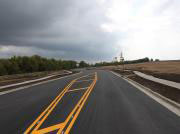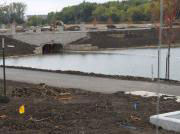Benefit District construction helps restore habitat
July 1, 2010
 OLATHE, Kan. - Before beginning work on the first building of the K-State Olathe Innovation Campus, months of time and energy went into the land upon which the building would be built.
OLATHE, Kan. - Before beginning work on the first building of the K-State Olathe Innovation Campus, months of time and energy went into the land upon which the building would be built.
In addition to putting in roads and utilities, the Benefit District for the Kansas Bioscience Park provided for the creation of a diverse ecosystem with open water, open prairies, woodlands and wetlands.
Wetlands absorb rainwater and allow it to return to aquifers, streams and rivers. They also help control flooding and erosion. Prairies are important because grasses native to Kansas have hardy roots that gather moisture and nutrients from deep in the soil, which means they can survive the weather extremes characteristic of the Midwest. Trees emit oxygen, which makes cleaner air for us, and open water provides a habitat for many species.
These various land features improve the area in several ways. Native plant species help stabilize stream banks to reduce erosion and sediment deposits. Replacing the invasive species with the native ones improves the habitat for aquatic and other wildlife, and it also provides flood control and better water quality on site and downstream. Of course, the fact that it looks nice does not hurt either.
Several other techniques are being employed to slow erosion. Rock riffles create a variation of depths in a stream, and plunge pools trap trash and sediment. Both structures slow water down and therefore reduce erosion. Also, the streams will be aligned to be longer with less steep banks – this will have a similar effect.
 Schlagel and Associates designed the plan to restore streams and create a better habitat in the park. Joining Schlagel were McAnany Construction, which took care of grading and other structural aspects of the Benefit District, and Arbor Masters, which managed the landscaping. Dennis Patterson represented K-State Olathe's interests with all the companies involved throughout the process.
Schlagel and Associates designed the plan to restore streams and create a better habitat in the park. Joining Schlagel were McAnany Construction, which took care of grading and other structural aspects of the Benefit District, and Arbor Masters, which managed the landscaping. Dennis Patterson represented K-State Olathe's interests with all the companies involved throughout the process.
Prior to this construction, non-native invasive species of grass combined with entrenchment, erosion and of sloughing of stream banks plagued the area.
A huge project, the cost of the Benefit District was split approximately 60-40 (divided based on acreage for each organization) between the Kansas Bioscience Authority and K-State Olathe. The total cost was $6.6 million.
- By Ashley Dunkak -